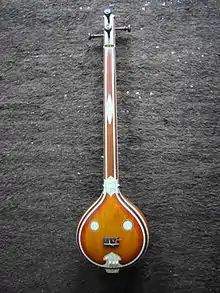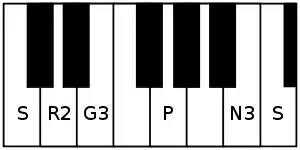Hamsadhvani
Hamsadhvani (meaning "the cry of the swan"[1]) also spelled as Hansadhwani, is a rāga in Carnatic music (musical scale of Carnatic tradition of Indian classical music). It is an audava rāgam (or owdava rāga, meaning pentatonic scale). It is a janya rāga of the Melakartha raga, Dheerasankarabharanam (29th) but according to Hamsadhvani's prayoga or the way it is sung it is said to be the janya of Kalyani (65th).
| Thaat | Bilaval |
|---|---|
| Type | Audava |
| Time of day | Early night, 9–12[1] |
| Arohana | S R G P N Ṡ[1] |
| Avarohana | Ṡ N P G R S[1] |
| Pakad | G P N - Ṡ N P G |
| Vadi | P |
| Samavadi | R |
| Synonym |
|
| Similar | Shankara |
| Carnatic music |
|---|
 |
| Concepts |
| Compositions |
| Instruments |
|
Hamsadhvani is also extensively used in Hindustani music and said to be borrowed into it from Carnatic music.[2] It was created by the Carnatic composer Ramaswami Dikshitar (1735–1817),[3] father of Muthuswami Dikshitar (one of the musical trinity of Carnatic music), and brought into Hindustani music by Aman Ali Khan of the Bhendibazaar gharana. It has become popular due to Amir Khan.
Structure and Lakshana

Hamsadhvani does not contain madhyamam or dhavathum. It is a pentatonic scale (audava-audava ragam[2][4] in Carnatic music classification – audava meaning 'of 5'). Its ārohaṇa-avarohaṇa structure (ascending and descending scale) is as follows (see swaras in Carnatic music for details on below notation and terms):
The notes used in this scale are shadjam, chatushruti rishabham, antara gandharam, panchamam and kakali nishadam. In Hindustani music, it is associated with Bilaval thaat (equivalent of Shankarabharanam).
Compositions
Hamsadhvani rāgam lends itself for elaboration and exploration and has many compositions in both classical music and film music. It is usually sung at the beginning of a performance.[2] There are many kritis (compositions) in praise of Lord Ganesha set in this musical scale.
- Jalajaskhiro an adi Talam Varnam
- Raghunāyaka,Śrī Raghukula and Abhishta varada by Tyagaraja in Telugu
- Vātāpi Gaṇapatiṃ by Muthuswami Dikshitar in Sanskrit
- Pāhi Śripatē by Swathi Thirunal Rama Varma
- Varanamukha vā by Koteeswara Iyer
- Mūlādhāra mūrti and Karunai seivai by Papanasam Sivan in Sanskrit and Tamil
- Gajavadana beduvae by Purandaradasa
- Vināyakā by Veena Kuppayyar in Sanskrit
- Varavallabha Ramaṇa by G. N. Balasubramaniam
- Gaṃ Gaṇapatē by Muthiah Bhagavatar
- Pirai Aniyum Peruman by Dr M. Balamuralikrishna
- Vinayaka Vighnavishaka by R Ganapati
- Sundar Gopālaṃ by Devaki Pandit
- Varuvai Arulvai Shantanayagi by Manachanallur Giridharan rendered by P. Unni Krishnan
- Tumbikkai Andavane by Manachanallur Giridharan rendered by P. Unni Krishnan
- Vinayaka Ninnu Vina by E.V. Raamakrishna Bhaagavatar
- Vande Anishamaham by Mysore Vasudevachar
- Bhajamahe Sree Vinayakam by Tulaseevanam
Film Songs
- "Lagi Lagan Pathi Sakhi Sang" from the movie "Meghe Dhaka Tara"
Language:Tamil
Related rāgas
Graha bhedham
Hamsadhvani's notes when shifted using Graha bhedam, yields another pentatonic rāgam, Nagasvaravali. Graha bhedam is the step taken in keeping the relative note frequencies same, while shifting the shadjam to the next note in the rāgam. For more details and illustration of this concept refer Graha bhedam on Hamsadhvani.
Scale similarities
- Mohanam is a rāgam which has chatushruti dhaivatam in place of the nishadam. Structures are shown in second table.
- Amritavarshini is a rāgam which has Prati Madhyamam in place of the rishabham. Structures are shown in first table.
- Gambhiranata is a rāgam which has shuddha madhyamam in place of the rishabham. Structures are shown in first table.
- Niroshta is a rāgam which has chatushruti dhaivatam in place of the panchamam. Structures are shown in second table.
| Rāgam | Śruti Tonic | C | D | E | F | G | A | B | C | |||||
|---|---|---|---|---|---|---|---|---|---|---|---|---|---|---|
| Hamsadhvani | C | S | R2 | G3 | P | N3 | S' | |||||||
| Amritavarshini | C | S | G3 | M2 | P | N3 | S' | |||||||
| Gambhiranata | C | S | G3 | M1 | P | N3 | S' |
In Hindustani music
Pakad or Chalan
Re Ga Re Ni Pa Sa Re Sa
The Pakad is the one where one can identify to which raga does the composition belongs.
Time
Late Evening [5]
Important Recordings
- Amir Khan, Ragas Hansadhwani and Malkauns, on HMV LP (long-playing record), EMI-EASD1357
- Lagi Lagana (Drut – Teental) by A. Kanan in Meghe Dhaka Tara
- Ja Tose Nahin Bolun Kanhaiya by Lata Mangeshkar in Parivar (1956)
References
- Bor, Joep; Rao, Suvarnalata (1999). The Raga Guide: A Survey of 74 Hindusthani Ragas. Nimbus Records with Rotterdam Conservatory of Music. p. 80. ISBN 9780954397609.
- Raganidhi by P. Subba Rao, Pub. 1964, The Music Academy of Madras
- P.P.Narayanaswami on www.carnatica.net
- Ragas in Carnatic music by Dr. S. Bhagyalekshmy, Pub. 1990, CBH Publications
- w.w.w.wikipedia
Literature
- Bor, Joep (ed). Rao, Suvarnalata; der Meer, Wim van; Harvey, Jane (co-authors) The Raga Guide: A Survey of 74 Hindustani Ragas. Zenith Media, London: 1999.
